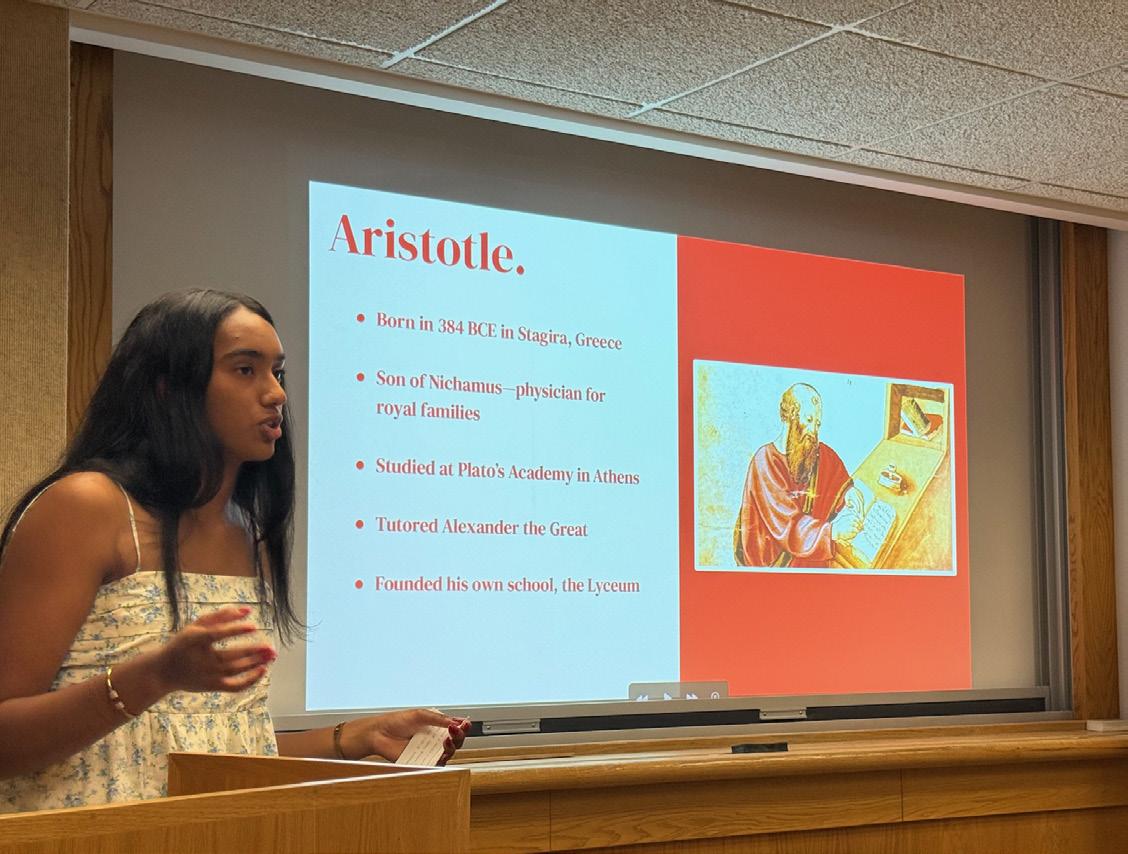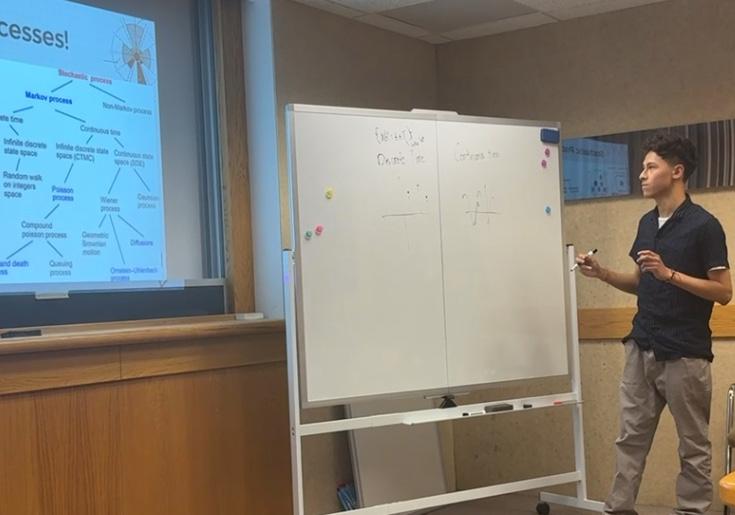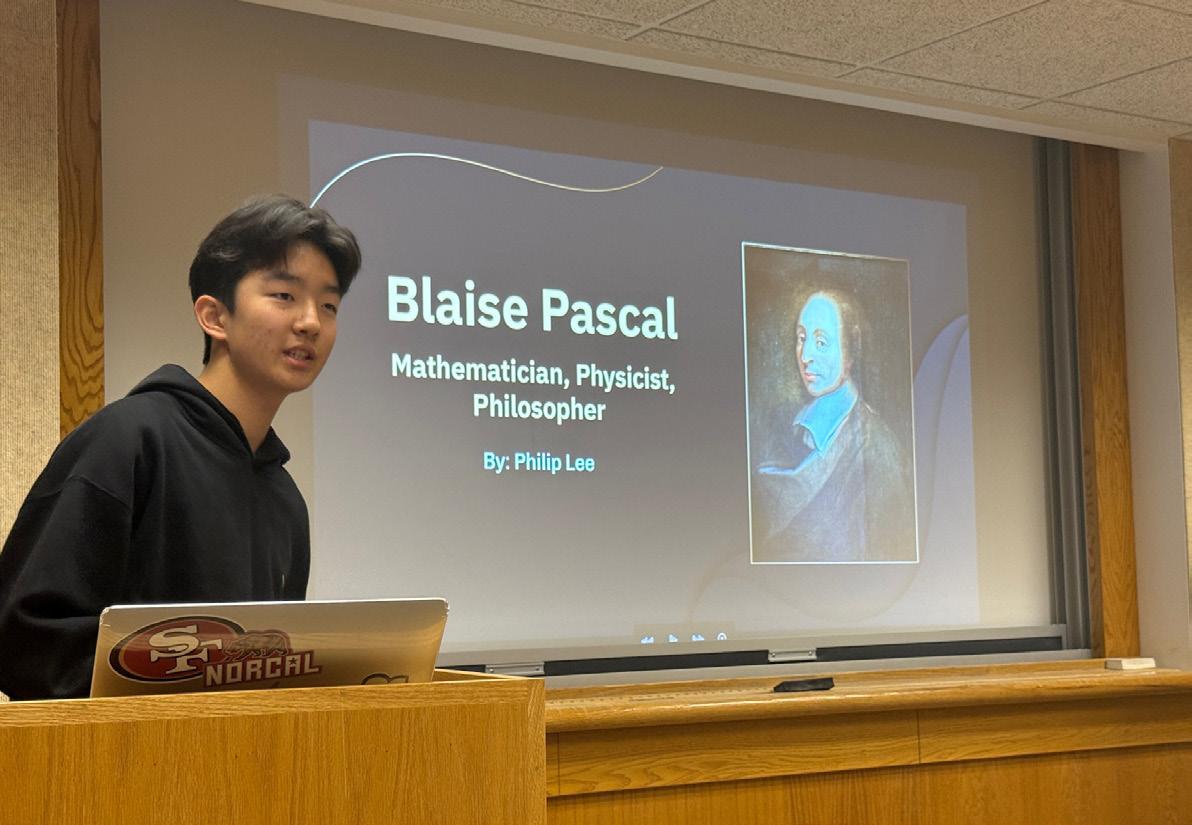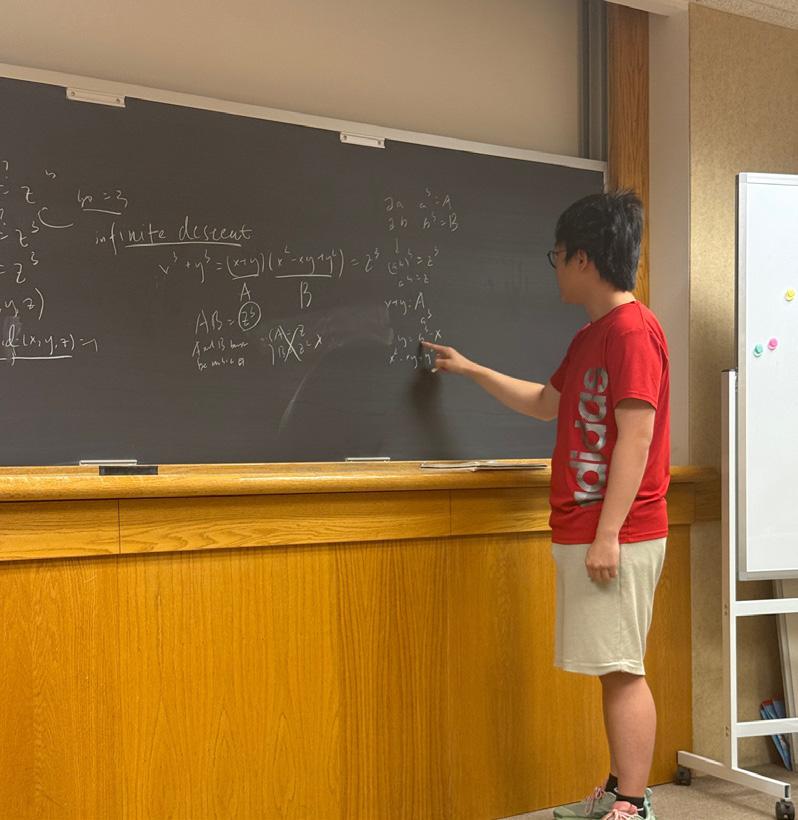Euclid to Einstein Scholars 2025 June






Dear Friends of the Euclid to Einstein Scholars Program,
This June was the inaugural run of the Euclid to Einstein program at Cornell. The university is known for its outstanding library collections in many disciplines, including (and especially!) mathematics. After much planning beforehand, we found ourselves on the beautiful campus in Ithaca, ready to do our work. But what is our work? First and foremost, we came to do research on the leading mathematicians and physicists of the past. Each student had picked a mathematician or a physicist whose life and work they wanted to study. We knew that Cornell libraries were outstanding. But as our work progressed, we began to realize just how spectacular Cornell libraries actually are. In addition to having full access to the math library, which seems to have every book on math over the last century, we also had access to Cornell’s Rare Books and Manuscripts Collections. Original editions of works by Newton, Euler, Descartes, Viète, and many others were made available for us as well as English translations of many foundational works originally published in Latin. We were thrilled to
hold in our hands these magnificent volumes that paved the way for the Scientific Revolution which shows no signs of slowing down.
We received a very warm welcome from the library teams and professors of Cornell’s mathematics department. Everyone here was looking for ways to make our stay more enjoyable and productive. Head of the Math Library, Henrik Spoon, looked after us, and checked in daily to see if everything was going well, helping students along the way (for example, by effortlessly producing the original volumes of world-famous Feynman’s Lectures on Physics, delivered when Richard Feynman, a Nobel Laureate in Physics, was a professor at the Cornell’s Physics department). Several professors from the Mathematics department came to speak with us about their work. Professor Lionel Levine spoke about AI, Large Language Models, and their power and pitfalls. Professor Moon Duchin delivered a fascinating talk about her research on how to draw electoral districts to achieve a fair outcome. She is a leading expert on this subject and highly sought-after expert witness at the state and federal level. Professor Timothy Riley spoke about Big Numbers. And Professor Tara Holm, head of the Mathematics Department, welcomed us on our first Monday morning, giving us an overview of how the department functions, and a tour of the campus.
We cannot be more grateful for their wonderful engagement with us, and, needless to say, we look forward to continuing our relationship.
The second goal of our Cornell visit was to learn more mathematics. We held daily classes on a variety of topics necessary for the History of Math and Physics course. We explored Vectors and Matrices, (re)“invented” Complex Numbers, and learned Taylor Series expansion and the famous Euler’s formula. Then we explored Linear Ordinary Differential Equations, Partial Differential equations, and Calculus of Variations, finishing with the foundational Euler-Lagrange equations. Using them, we proved that a straight line truly is the shortest path between any two points on a plane (hard to believe, but mathematicians get excited about proving these “obvious” things!).
It has been a challenging, busy, and productive visit. I look forward to our stay next year. It will be great to reconnect with our Cornell colleagues, and continue to explore the life and work of outstanding mathematicians and physicists of the past. Just about everything we see around us today would not exist had it not been for their genius, foresight, and hard work.
Sincerely, Mr. Ginzburg


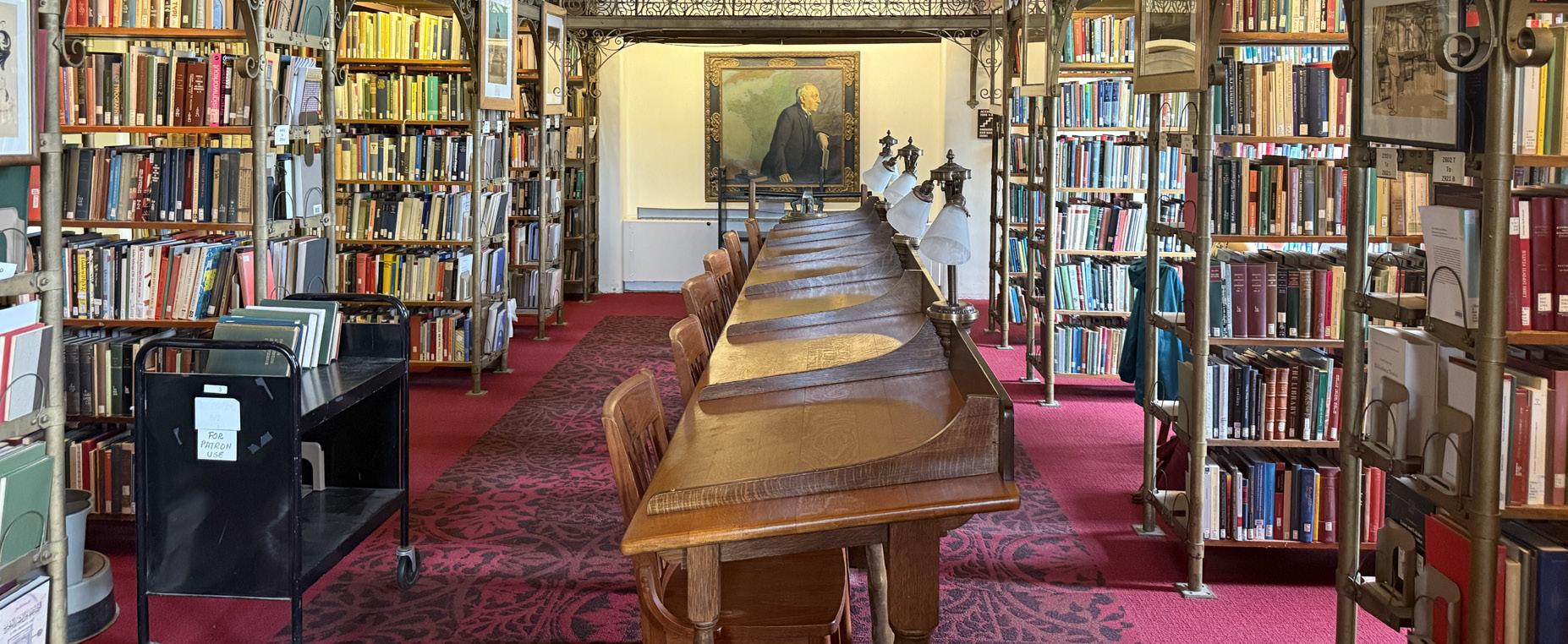
An essential aspect of the Euclid to Einstein Scholars Program was the incredible opportunity to conduct archival research on our luminaries at Cornell’s mathematics library, Olin Library, Uris Library, and the Rare Books and Manuscripts Collections. These libraries offered us special access to the original texts, old biographies, complex diagrams, and centuries-old manuscripts that brought our research to life.
At 9 a.m. each morning, we gathered in the reading room, surrounded by shelves of books and digital sources. With the guidance and support of Cornell’s experienced and skilled librarians—who helped us navigate the catalog, locate materials, and handle fragile manuscripts—we delved into original and supporting work of our chosen mathematicians and physicists. The Rare Books and Manuscripts Collections houses thousands of rare and important mathematical and scientific volumes and manuscripts—works that some of us uti-
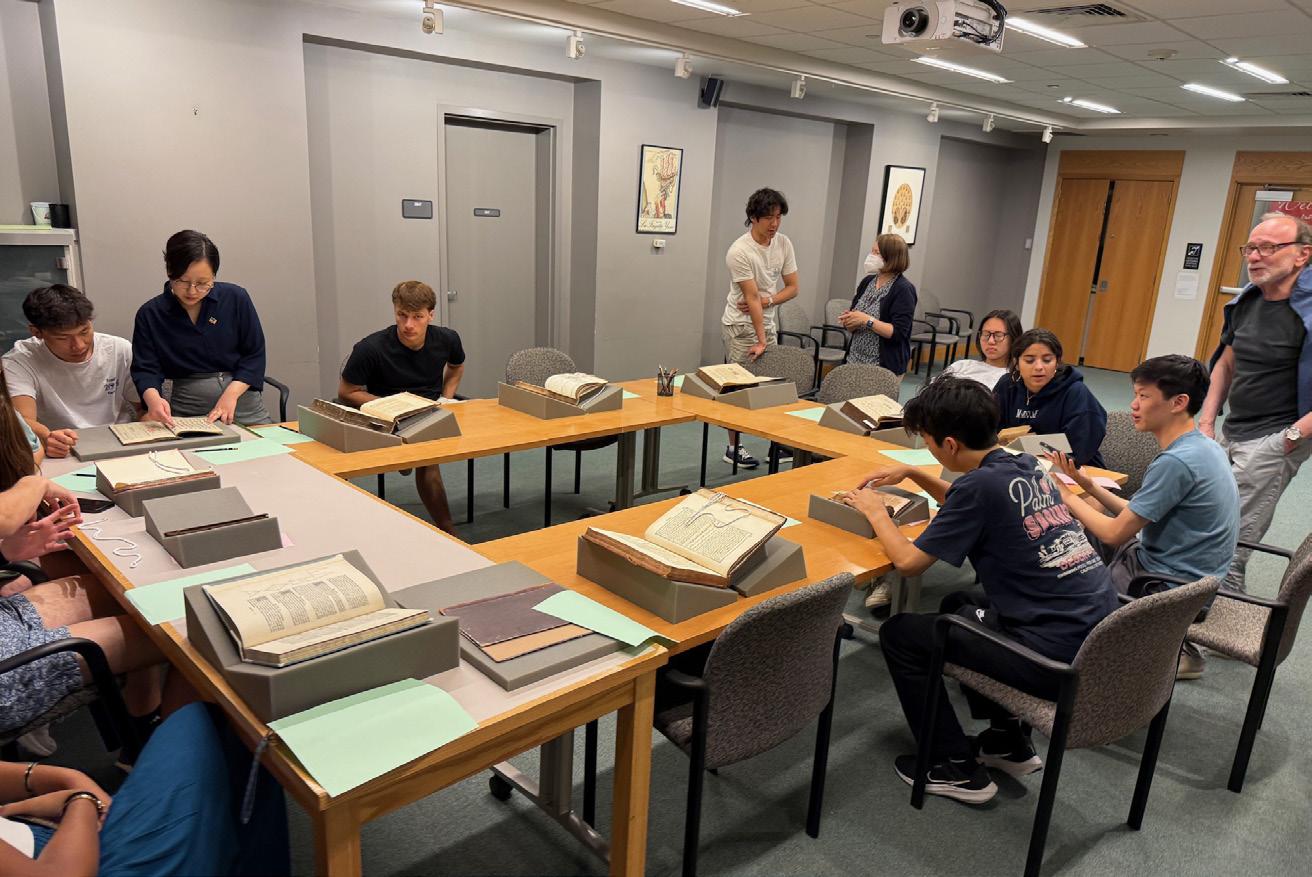
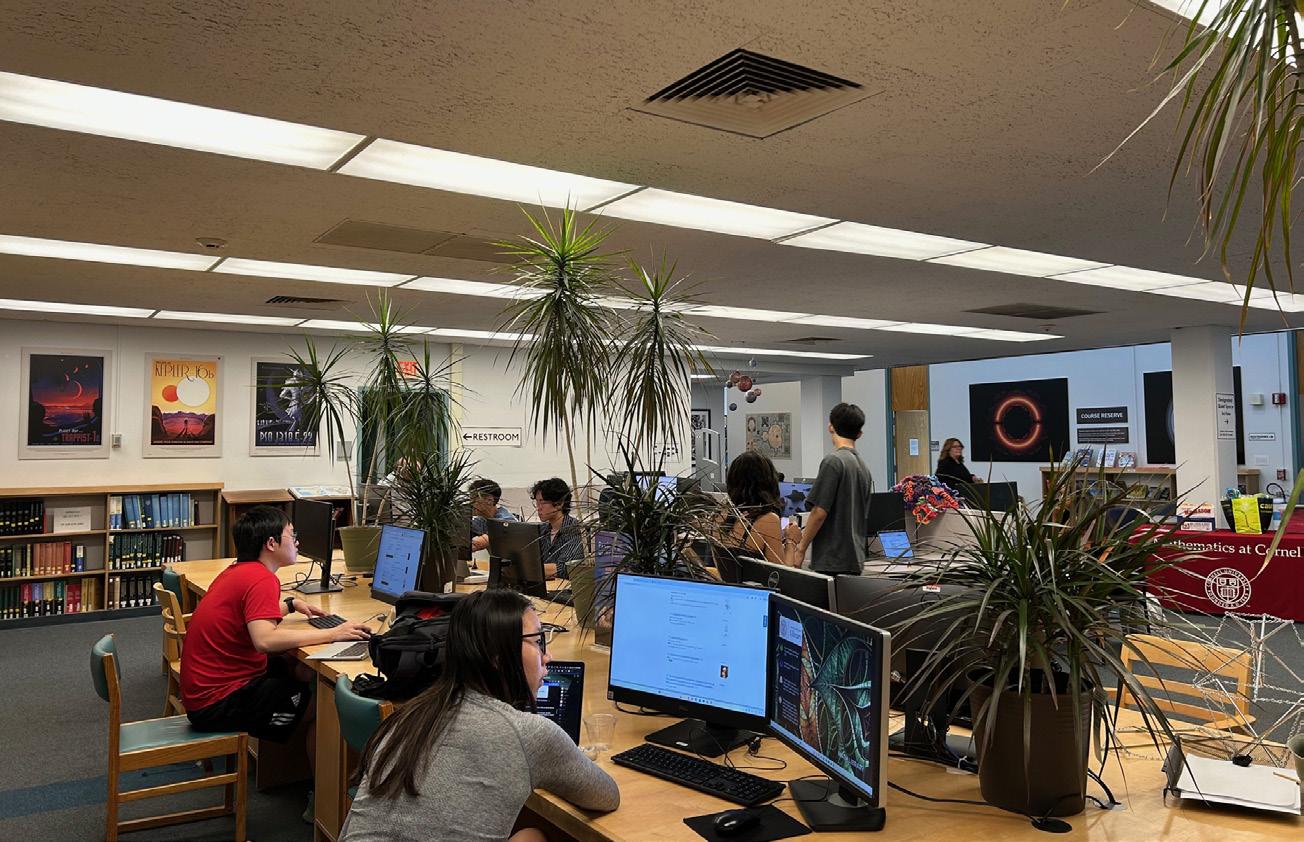
lized in our independent research. We were especially excited by the opportunity to conduct research on the original works of famed mathematicians, such as Euclid’s Elements or Newton’s Notebook, and we spent countless hours analyzing delicate diagrams, studying marginalia, deciphering symbols, and uncovering the influence of social and cultural context on the development of our luminaries’ work.
The experience not only deepened our understanding of the work we were studying, but reminded us of an important lesson: mathematics and physics are far more than formulas and numbers—they are a living history of ideas passed down and reshaped over several generations. The opportunity to work with such rare works added depth to our research, and we are especially grateful to the dedicated librarians who made this opportunity possible.

Luc Barrett Instructor

Mika Misawa Residential Assistant
Each afternoon, following our work in the archives and lunch at Cornell, we would transition to math classes that spanned three hours. We began with mathematical induction, through which we learned to build mathematical arguments that held true for infinitely many cases. The class was taught by resident assistant and mentor Mika Misawa, a recent Cornell graduate with a double major in mathematics and philosophy. Furthermore, during our class on induction, we were introduced to “cake numbers”—the maximum number of regions a cube can be divided by n planes. From there, the concepts we learned grew larger and more complex. Luc Barrett, an incoming Cornell PhD student in physics, and Mr. Ginzburg taught us many topics including: Taylor series expansions, calculus of variations, hyperbolas, linear differential equations, functionals, Fermat’s Principle, partial differential equations, complex numbers, and the foundations of Linear Algebra.
Through studying calculus of variations, we were taught how to find functions that minimize certain values—a tool with many applications to engineering and physics. Later topics added depth to our mathematical understanding, and we were consistently amazed by how the concepts connected to one another and to the physical world.
Some of the most thrilling moments arose when we were taught how to apply the abstract ideas we had learnt in
previous lessons to real-world problems. In one class, we used partial differential equations to calculate how heat moves across a rod, allowing us to predict physical phenomena with precision and accuracy. Furthermore, we used partial differential equations, functionals, chain rule, and integration by parts to work through the logic behind why a straight-line segment is truly the shortest path between two points. It is interesting how complex the logic behind such a basic fact is, and often we take these “simple” mathematical facts for granted. Looking back, Euler’s formula stands out as one of the most pleasing results we encountered as it links exponentials, trigonometry, and complex numbers in an almost unimaginable way.
Beyond daily classes, our learning extended to evening study halls where we worked collaboratively, alongside teaching assistant Luc Barret, on problem sets that pushed us to apply the concepts we learned and solidify our understanding. The evening sessions were difficult but rewarding, allowing the scholars to develop creative strategies to walk through rigorous math problems.
By the end of the two weeks, Scholars came away with new mathematical knowledge, along with a deeper appreciation for how mathematics reveals much of the structure of the world around us.
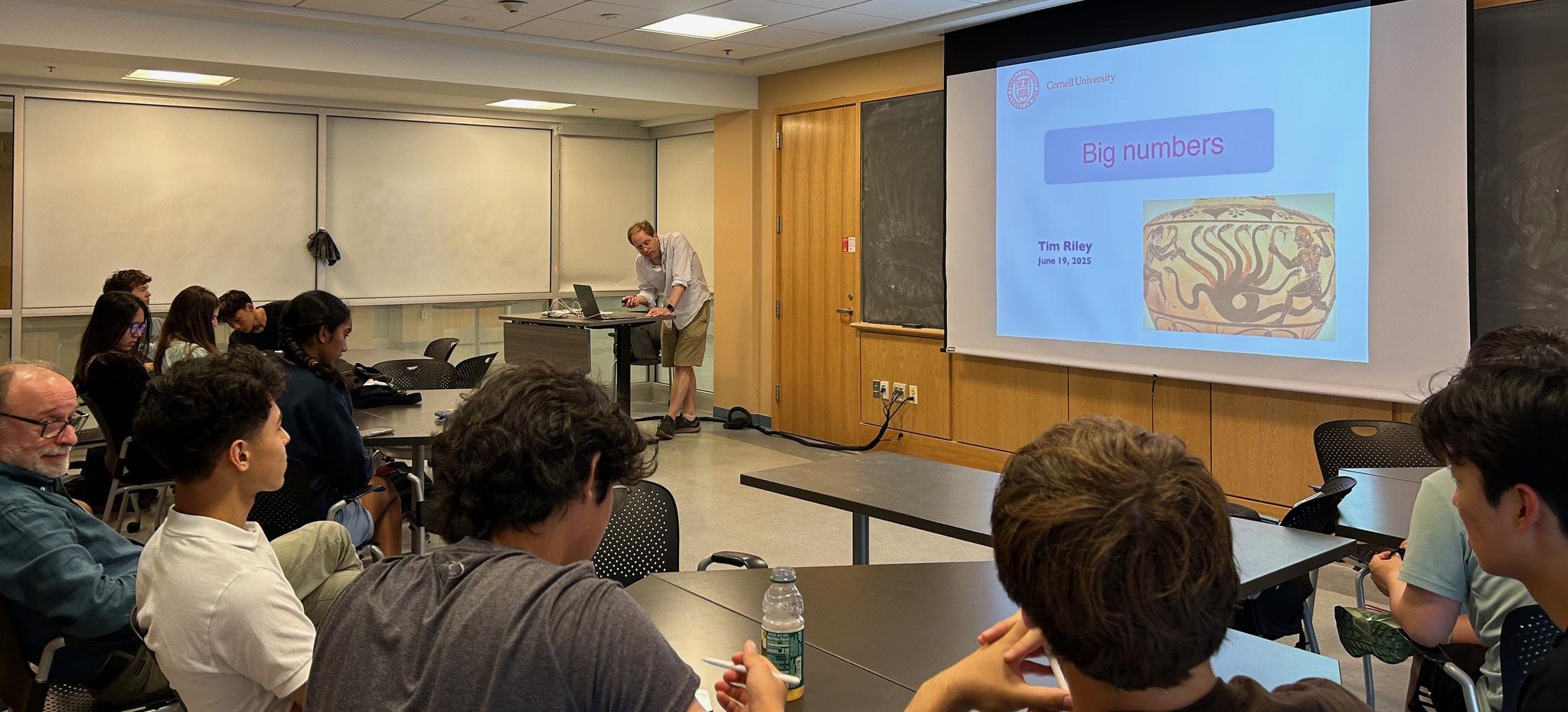


Life in Court-Kay-Bauer hall—one of the many residential buildings on Cornell’s North Campus—was one of the most memorable and meaningful parts of our time at Cornell. Outside of class, scholars found many ways to relax, have fun, and—most importantly— bond with each other. On many evenings after classes, we would head to the beach volleyball courts. Despite many of us not knowing how to play volleyball prior to our time in the program, several hours spent at the courts allowed us quickly to learn, and games ended with plenty of laughs. It became a tradition to gather on the bridge to watch the sunset—or, on occasion, the sunrise—with our “Spotify Jam” playing in the background.
Inside the dorm, there was never a dull moment. Spikeball games popped up in the hall-

way, turning competitive as people would dive for the ball, hoping to outplay each other. Even more, the common room was always full of energy, with people engaging in intense games of pool, ping pong, and just hanging out.
One of the best parts of dorm life was learning new card games together. Whether it was Chinese Break the Egg, President, or Bluff, there was often a group of students at the table teaching others, playing, and laughing. While we had attended school with each other for the past few years, these small moments in the dorm—sharing snacks, telling stories, and playing games—allowed us to create tightknit, lasting friendships that we look forward to continuing in our Senior year.


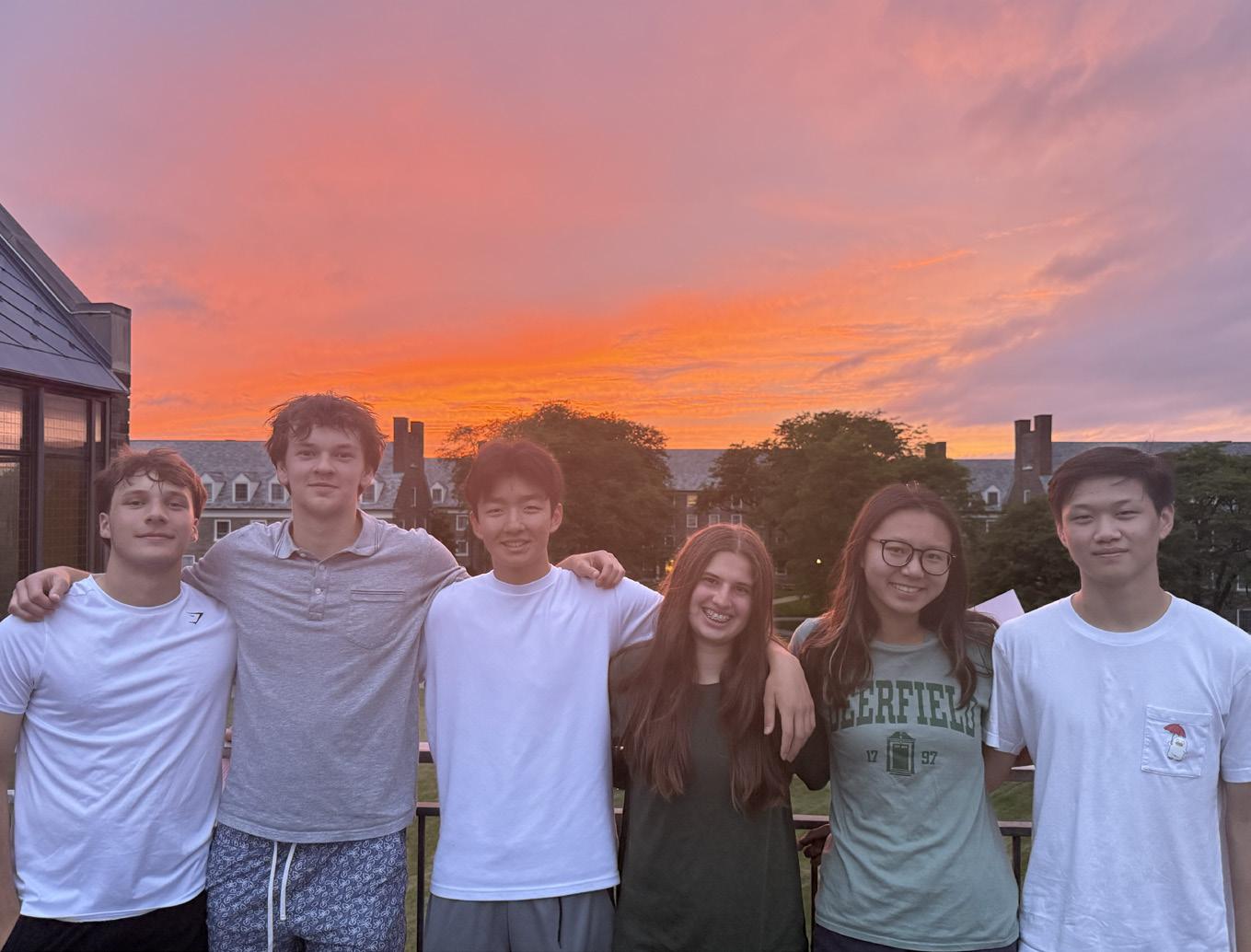

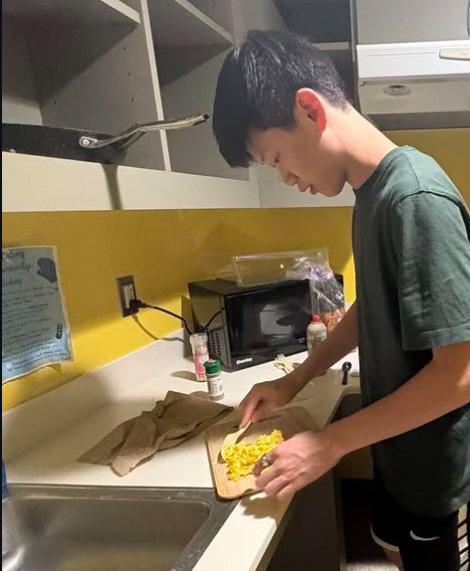

Tracing Mathematical Lineage
Pierre de Fermat was, as his biographer puts it, “a judge by profession, a mathematician by passion.” I was fascinated at first by his last conjecture (now theorem) and how an amateur who rarely published could still launch entire fields of mathematics. At the Rare Books and Manuscripts Collections, I came across three separate restorations of the same book by Apollonius of Perga, a foundational figure in ancient Greek geometry. One of these restorations was by Fermat himself. Seeing how different mathematicians over centuries reconstructed and reinterpreted the same classical text offered a window
into the evolution of scientific thought. Alongside this, I reviewed Fermat’s complete works, a supplement volume, a physics treatise, and a German edition on his maxima and minima methods. These showed how his technique of adequality anticipated core concepts of calculus.
To continue my research, I turned to Mahoney’s Career of Fermat, Devlin’s Unfinished Game, and Singh’s Enigma, which helped me understand how Fermat’s ideas bridged ancient geometry and modern analysis. Looking ahead, I hope to explore how Fermat’s methods influenced later developments in calculus and mathematical proof, especially through his correspondence with Pascal and Wallis. During the spring course, I plan to translate key Latin excerpts and analyze how his approach, such as that to the concept of “adequality,” reflects a period of transition in mathematical thinking.


I’ve always heard about Einstein’s amazing scientific breakthroughs, and I wanted to spend some time getting a more solid understanding of his theories and life. For the purpose of this program, that meant learning about the interplay between his personal, social, and political life with his scientific breakthroughs. Einstein dropped his first batch of serious scientific insights in 1905, and he shared his game-changing General Theory of Relativity ten years later. The collection of books held at Cornell tell the story of how this impressive scientific feat was met by an unfortunate, antisemitic resistance to his ideas. The quality of his ideas eventually overcame this injustice, as experimental evidence proved him right in 1919, and later, his ideas earned worldwide acceptance. With General Rel-
ativity, Einstein resolved the lingering problems left by Newton’s centuries-old conception of gravity. With his discoveries about E = mc 2 and the existence of photons, he laid the groundwork for atomic bombs and quantum mechanics. Einstein ended his life with an unfinished search for a unified theory of the universe, something still open for us to resolve today. In the spring, I’ll continue reading through the sources I’ve found at Cornell’s libraries and learning about Einstein’s contributions.
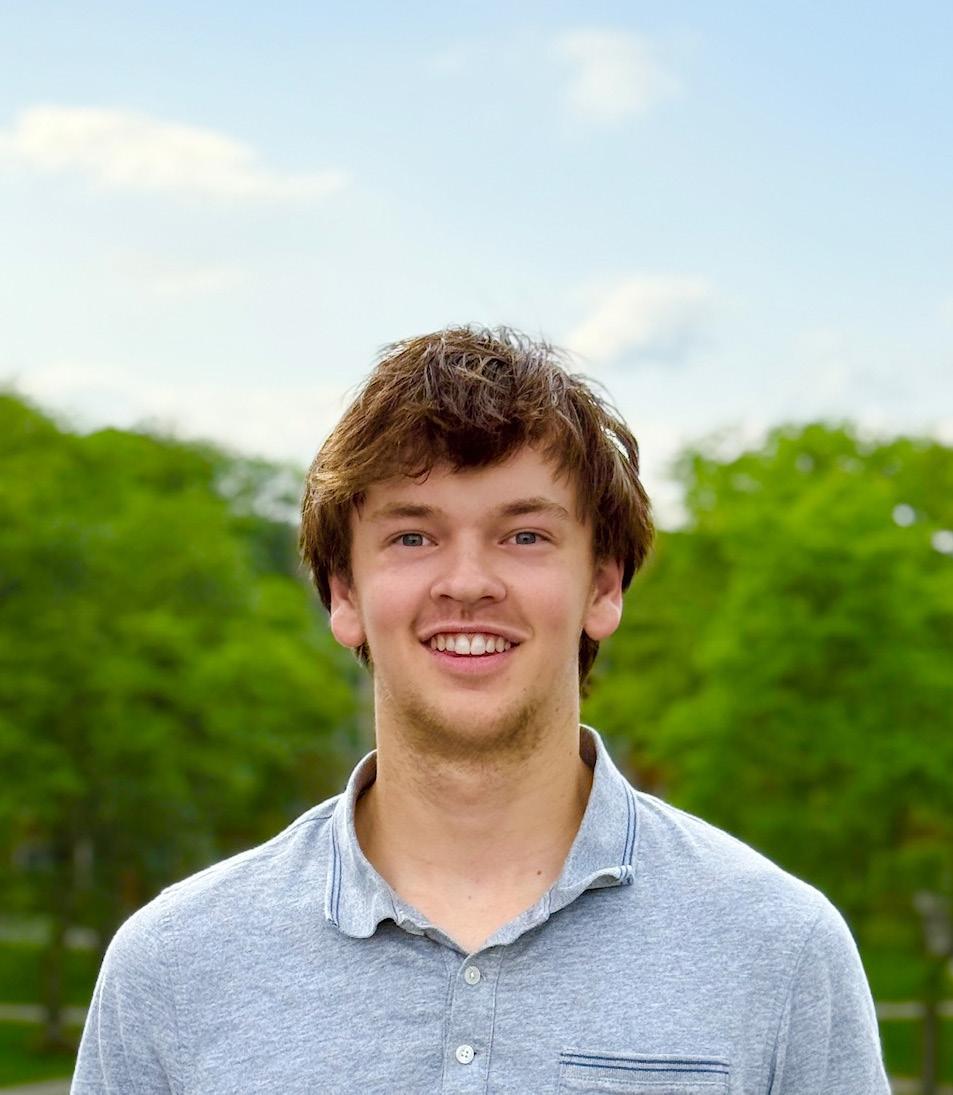
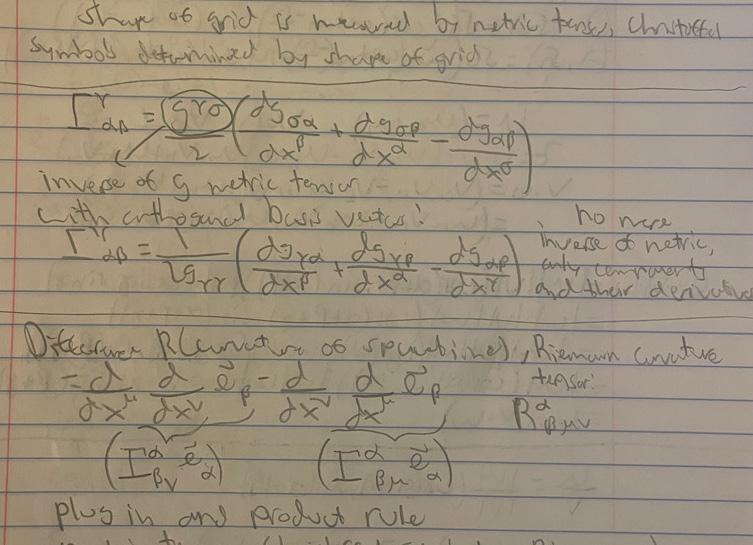
I chose Einstein as my luminary. He is one of the greatest and best known scientists in history for his work on Special Relativity, General Relativity, Brownian Motion, and the Photoelectric Effect.
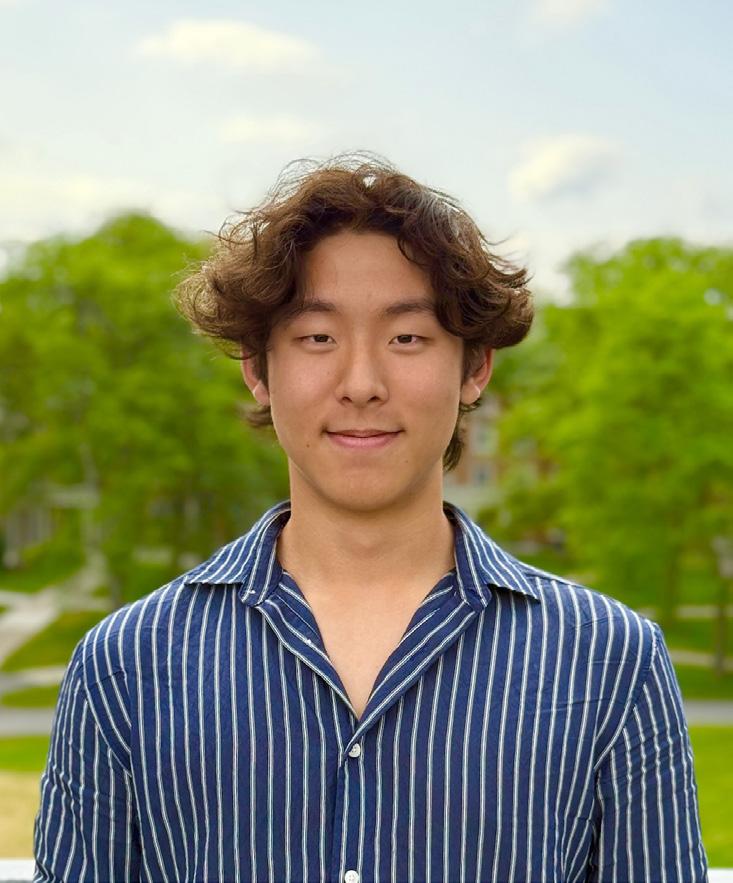
I chose Archimedes as my luminary of interest at Cornell. As a scholar of Classics and mathematics, I have always been intrigued by how great minds of antiquity conceived mathematical notions that laid the foundation for modern technological feats. Naturally, Archimedes struck me as the prime choice. As a native of then-Greek Syracuse
I had initially chosen Newton, but I quickly switched to Einstein because of my fascination with time dilation after watching Interstellar. For most of the time at Cornell, I chose to focus on un-
in Sicily in the 3rd century BC, he made profound contributions to mathematics, physics, and engineering by proposing laws of mechanics and estimating volumes and areas of various geometrical shapes by applying the idea of infinitesimals and the method of exhaustion, which anticipated integral calculus by two thousand years.
I dedicated much time at the Rare Books and Manuscripts Collections, where I examined 16th- through 18th-century compilations of Archimedes’ works scribed in Ancient Greek and Latin. Analyzing authentically preserved forms of Archimedes’ diagrams and writings firsthand in conjunction with edited, published modern
derstanding the math behind General Relativity, which is a theory that describes gravity as the curvature of spacetime rather than a force. The most fascinating thing I learned about him during my time was that Einstein had added a Cosmological Constant to his theory of General Relativity in order to make the model consistent with the notion that the Universe was unchanging. However, later on, it was discovered that the Universe is indeed expanding and his original theory is correct and no fudge factor is needed. While this finding wasn’t a key insight into his personal life, nor one of
English compilations yielded a fascinating experience of archival study in which I was challenged to understand his work in a similar mode as it had inspired later Renaissance and Enlightenment thinkers like Galileo, Newton, and Leibniz. Further,
his major contributions, it highlights the fact that Einstein was a true genius, since his theory predicted what we had not yet observed. In the spring, I’m most excited to learn more about his philosophies, especially on humanism, and how they affected his work.

investigating the social forces from which Archimedes’ works sprung enriched my understanding of the history and legacy of the ancient intellectual tradition, which I hope will invigorate my study of Classics at Hotchkiss and beyond.
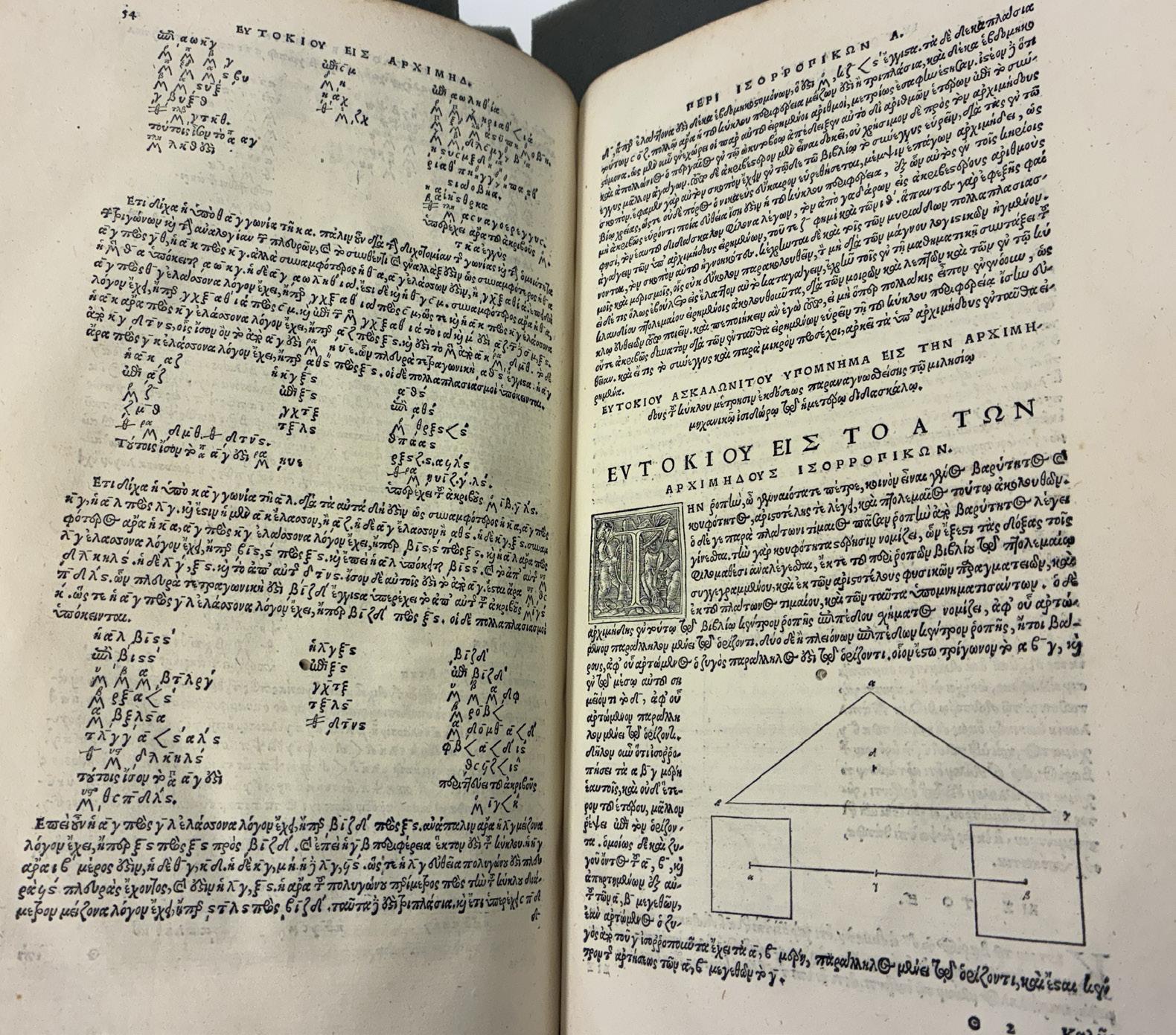

Geometry, Gambling, and God
My research was on Blaise Pascal, a French mathematician, physicist, and philosopher. Pascal was a polymath, devising Pascal’s Theorem and Pascal’s Law while making significant contributions to fluid mechanics, probability theory, and the comprehension of Pascal’s Triangle. What initially intrigued me was his philosophical reasoning, specifically Pascal’s Wager: a philosophical argument proving the rationality behind believing in God. While conducting more research, I was particularly fascinated by Pascal’s probability theory and subsequent utilization of his triangle, which I found provides practical implementations when
determining chance in our everyday lives. The Math and Olin libraries provided great resources that helped illustrate Pascal’s numerous concepts and provided additional insight into the environmental factors that enabled him to conduct his studies. I’ve gotten the privilege to search through the archives where I obtained access to his work. In my most recent session, I examined his multiple essays and treatises along with a set of letters exchanged by Pascal and Fermat where they attempted to solve gambling problems utilizing their probability theory prototypes. At another archival session, I looked through some of Pascal’s socalled miscellaneous writings along with his written thoughts regarding his philosophical and religious beliefs. I’ve enjoyed my studies in Cornell and I look forward to further examining my resources this coming year.
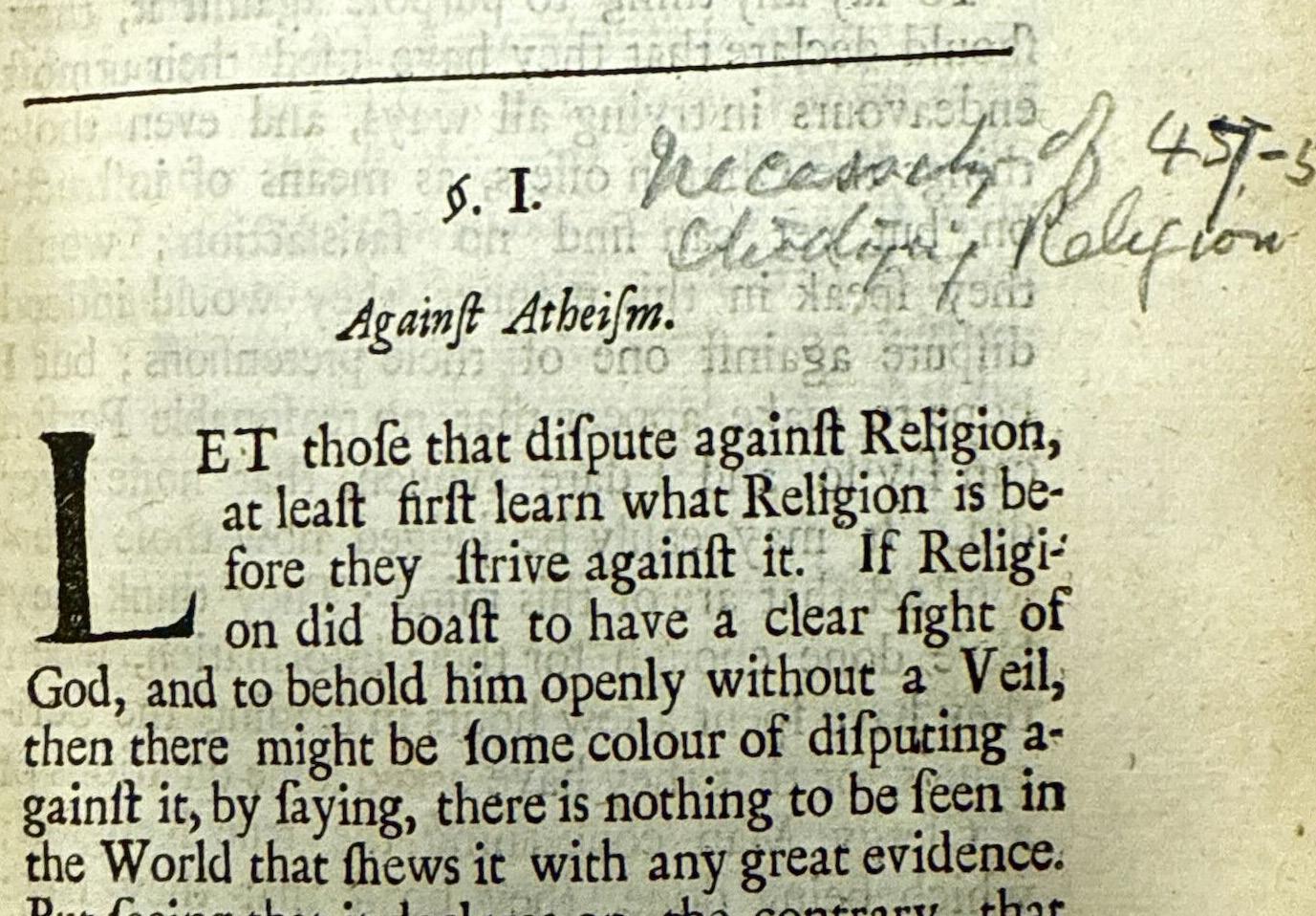

After switching my person a few times, I settled on François Viète, who was a mathematician known as the father of symbolic algebra. I was particularly intrigued that although Viète was French, he wrote all of his mathematical work in Latin which was the academic language of his time. One of his most fascinating contributions was that he introduced symbolic notation, using consonants for knowns and vowels for unknowns.
To look at primary sources, I visited the Rare Books and Manuscripts Collections at Cornell which had two volumes of his original Opera Mathematica. I examined the original Latin and photographed and translated pages that seemed interesting. While his book included much interesting
information on geometry, logic, Gregorian Calendar, and angular sections, my research led me to focus on his algebraic discoveries, which had the most lasting effect on the development of mathematics. Hence, I focused on his introduction of letters as variables, Viète’s formulas (the relationship between the coefficients of a polynomial and the sums and products of its roots), and his infinite product for π. There is still so much to uncover about Viète’s math and I look forward to writing my paper for next spring.

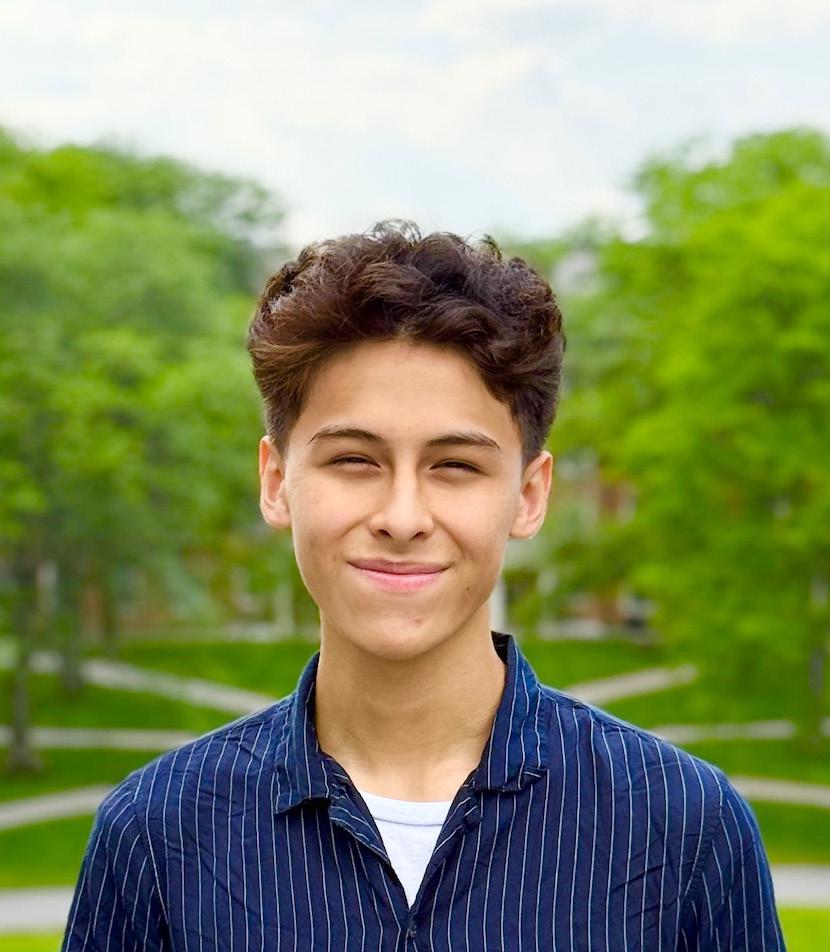
My research at the Cornell Mathematics Library and Rare Books and Manuscripts Collections centers around one of the leading Japanese mathematicians of the 20th century, Kiyoshi Itô. Known as the father of stochastic analysis, Itô reshaped how we understand randomness with stochastic differential equations (SDEs) and what
Initially interested in logic, I chose to research mathematician, physicist, and philosopher Aristotle, often referred to as the “father of logic.” At Cornell, I began exploring the intellectual legacy of Aristotle with a particular focus
is now known as Itô calculus. His work is primarily used in quantitative finance, physics, and biology to model previously inexplicable phenomena such as Brownian motion. My initial interest in him stemmed from my curiosity in both management and technology. Rummaging through his publications, university lecture notes, and translated work from Japanese, I became increasingly intrigued by the depth of what defines a stochastic process. Within that process lies time evolution and state space, with Itô’s work in the most confusing realm: continuous state space—an uncountably infinite number of possible states in a system that evolves randomly over time. Yet, in-
on his work in the fields of logic, mathematics, and physics. As part of this research, I examined Euclid’s Elements at Cornell’s Rare Books and Manuscripts Collections to understand how Aristotle’s logical principles, such as the use of axioms and demonstrative reasoning, helped

terestingly, his work was nowhere near as appreciated at the time of its discovery. For context, Itô’s infamous paper On Stochastic Processes was published during World War II, with limited communication to the Western world. I am extremely grateful to have had the opportunity to begin early research on Itô and am excited for the upcoming school year, where I will dive

shape foundational geometric principles and the development of later, more rigorous scientific theories. I also engaged with more modern interpretations of Aristotle’s work that highlight the enduring influence of his ideas across several disciplines, as well as older sources within the Mathematics Library that critiqued his scientific theories as fundamentally flawed. Early in my research, I became especially interested in how many of Aristotle’s theories, particularly in mathematics and physics, were later proven incorrect. This led me to shift my focus toward examining the root of his inaccuracies and the lessons we
deeper into the sources I’ve already found and strengthen my understanding of the mathematical framework behind stochastic processes. It has been truly fascinating to see how finance, mathematics, and engineering have intersected in the work of Itô, building on the legacy of mathematicians before him.
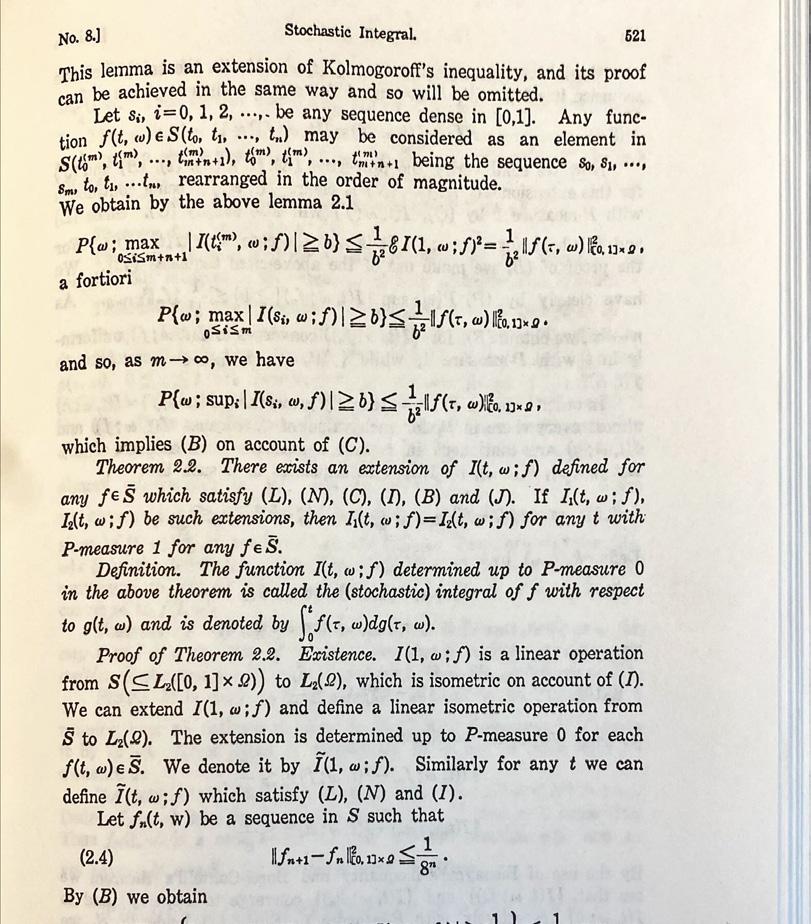

Sia Reddy
can learn from his errors in process and result. My goal is to continue analyzing both the strengths and flaws in his thinking to show that Aristotle’s true legacy lies not just in his claims, but in his methods—and what they reveal about the importance of demonstrative, disciplined reasoning over dogma and tradition.
Anya Reppa
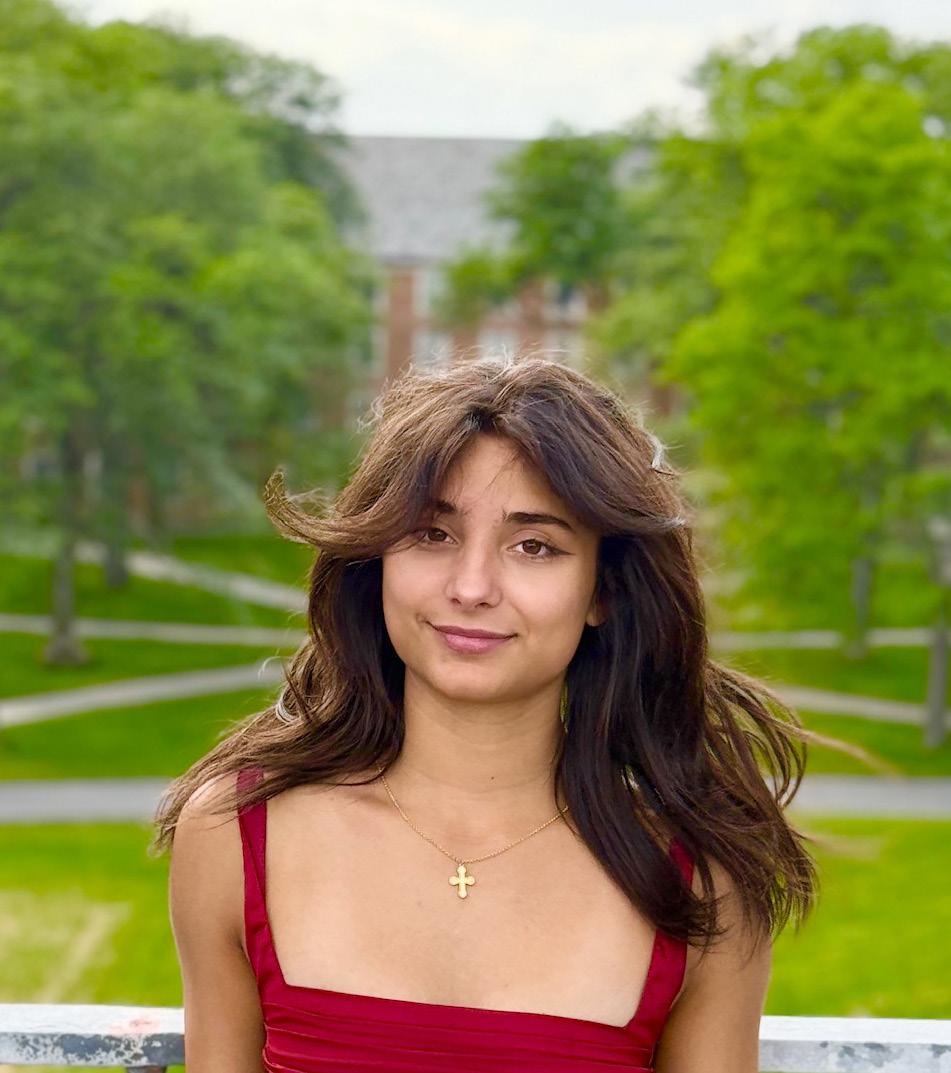
Ada Lovelace, the Mother of Computing
I chose to center my research around the life and work of Ada Lovelace, which also allowed me to follow the evolution of early computers. While at the Cornell Mathematics library, I traced the origins of computing back to the French textile industry and the invention of the jacquard loom—an early punchcard system that used sequences of circular holes to encode complex machine-woven patterns. It was Lovelace’s notes on the Jacquard loom as well as another early computer, Charles Babbage’s analytical engine, that served as some of the
first computer programs and changed the trajectory of computing beyond simple calculations. I found the Mathematics library to be rich with detailed blueprints and diagrams of the analytical engine. Since the engine was never completed, the drawings were instrumental in helping me understand the machine’s mechanics as well as the process of transforming Lovelace’s punched code into complex calculations. I was also able to access a number of books containing transcripts of Lovelace’s letters. These included thoughts that were vastly influential on the work of Alan Turing as well as our current understanding of artificial intelligence and its capacity for sentience. For example, her objection that while opportunities for computing are limitless, a computer has “no pretensions whatever to originate anything. It can do whatever we know how to order it to perform.”


During my time at Cornell, I chose to research Albert Einstein—not only for his accomplishments and contributions to physics and mathematics, but also to explore how the personal, political, and social contexts of his life shaped his work.
Working alongside my peers, Crea Kibar and Dwyer Illick, who also chose Einstein as their luminary, I began by understanding his greatest theories, such as special relativity and general relativity. As I became more aware of how complex and revolutionary Einstein’s theories were, I also began to wonder about the effect they had on society. This led me to Cornell’s Math Library and Rare Books and Manuscripts Collections, where I searched for direct sources covering both Einstein’s theo-
ries and the reactions they provoked. I found that his greatest works emerged in the early 20th century which was marked by World War I and a rising tide of antisemitism, especially in Germany, where Einstein was born.
I am excited to continue my research in the Spring and delve deeper into the mathematical explanations behind Einstein’s theories. My final research paper will combine these aspects and showcase all I have learned in the process.


primary texts through the Cornell Library Catalogue.
I started my research project on Descartes by gathering secondary sources and

God, Gravity, and Apple: A Look Inside Newton’s Manuscripts
I chose Isaac Newton as my Mathematician of interest at Cornell because I wanted to learn more about how his religious beliefs influenced his scientific work. Cornell also has numerous resources about Newton both in the Rare Books and Manuscripts Collections and the Math Library. Isaac Newton
I had known of his philosophical contributions, so I found his impact as a mathematician even more interesting and impressive. I started with comprehensive biographies on the University of St. Andrews Math History MacTutor site to build basic knowledge. I gathered specific volumes and texts from the Olin Library, Math Library, and Rare Books and Manuscripts Collections, though many were in French and Latin. My research was structured around the novelty of Descartes’ contributions
was a 17th-century English mathematician, physicist, and opticist who is considered the founding father of modern science, classical mechanics, optics, and calculus. Through inventing the three laws of motion and universal law of gravitation, Newton was able to explain every motion we see around us – from celestial motion to the motion of everyday objects like an apple dropping from a tree.
I spent much time in the Cornell RMC, examining Newton’s 17th-century works in a blend of ancient Greek, Latin, and English. I was intrigued by his thought process behind the three laws of motion. One of the works that
to mathematics, and how he was able to create commonly used mathematical concepts such as Cartesian coordinates. To answer these questions, I traced social order and academic funding in seventeenth-century Europe, examined his family background and educational influences, and mapped his collaborations with other mathematicians like Fermat. He invented analytic geometry by introducing a coordinate system that translated geometric curves into algebraic equations. In his 1637 treatise La Géométrie, he showed how equations such
I investigated was Newton’s Notebook from his days at Trinity College. I used AI to translate the manuscript into English, and discovered that Newton’s notes had deep theological roots. He believed nature’s laws were the design of God. Newton also rejected Aristotle’s ideas on motion and referenced
as the standard form of representing straight lines and algebraic methods could be used to solve classical problems of tangents and intersections. In the spring, I hope to have a better conceptual understanding of analytical geometry to recreate some of Descartes’ work.

Descartes’ ideology of inertial motion in his creation of the first law of motion. My future plan regarding Newton in the spring course is to further unpack his physicist contributions to the scientific world, specifically focusing on understanding his differential equations.





Our time at the program outside of our research was about bonding, adventure, and making unforgettable memories with one another. Throughout our two weeks in Ithaca, we got to explore the town and beyond through several amazing trips.
We began with a trip to Ithaca downtown for Circus Culture. There, the instructors taught us how to juggle, balance, and do acrobatics. Although we quickly came to realize that gravity always wins, we enjoyed cheering each other on, and laughing when we fell.
On our weekend off, we traveled to Six Flags at Darien Lake, NY. The bus ride itself felt like a party, with everyone playing music, games, and engaging in good conversation. Upon arrival, we teamed up to conquer the many roller coasters and games, enjoy some wings, fries, and the amusement park classic—Dippin Dots. Later in the afternoon, the group enjoyed the rides and slides within the water park. The day was filled with smiles, laugher, screams, and energy—the Scholars would surely name the trip a highlight. Upon coming back, we enjoyed Chinese food and poke
bowls in the common room!
Nature had its own way of wowing us, particularly during our visit to the Robert H. Treman State Park to see one of Ithaca’s famous gorges, Enfield Glen. The views of the waterwall were breathtaking, and the trails wound through lush greenery. We paused to take it all in, taking group photos, wading in the water, playing volleyball, and skipping stones. The trip was a reminder of how beautiful Ithaca is, and how truly lucky we were to experience it together.
Finally, we several trips to Collegetown throughout our time at Cornell. We went out to eat an array of cuisines, attended Ithaca Pride, and went on bubble tea and 7-11 runs. These moments, small or big, helped turn our group of math scholars into a real community with so many unforgettable memories to take away.
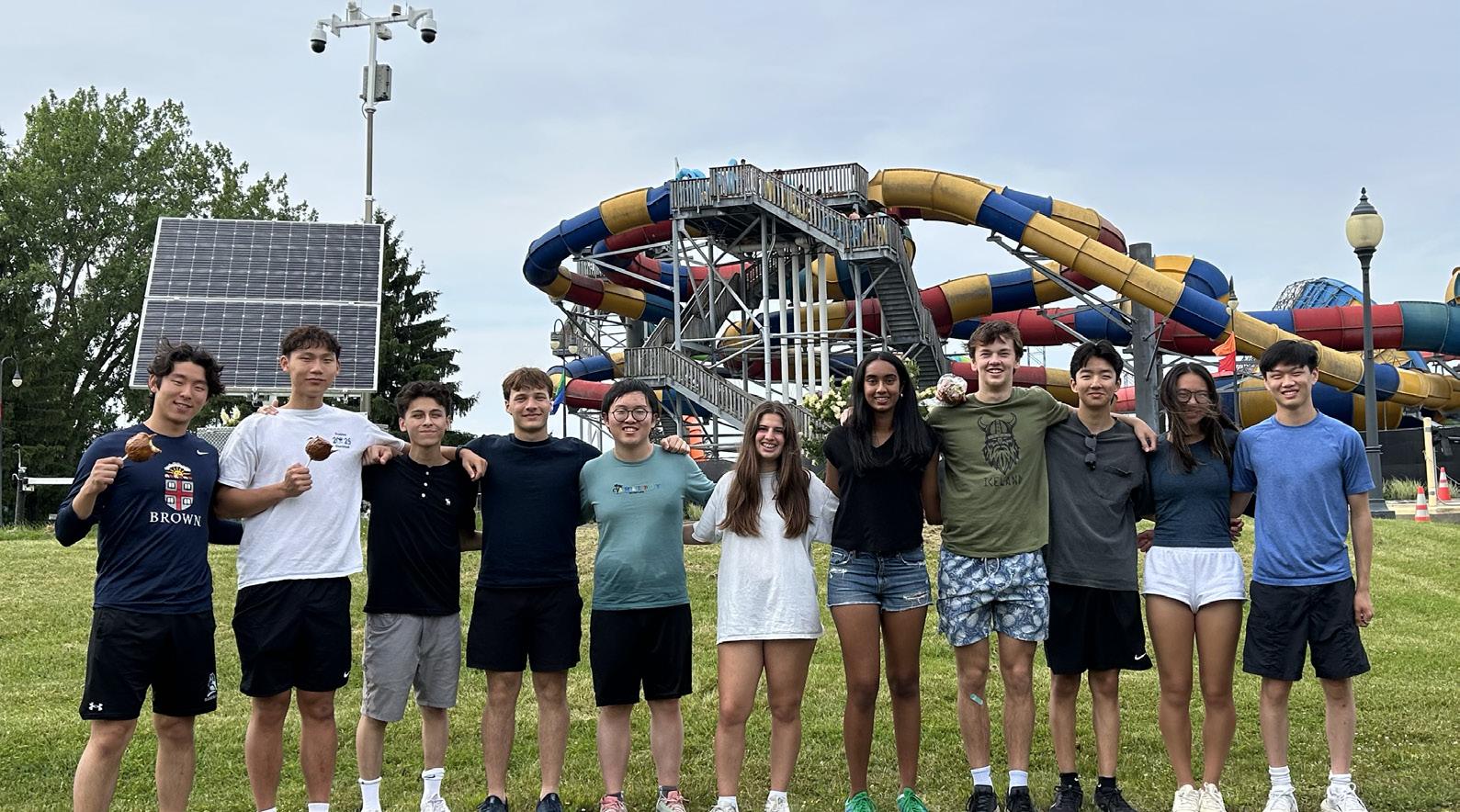

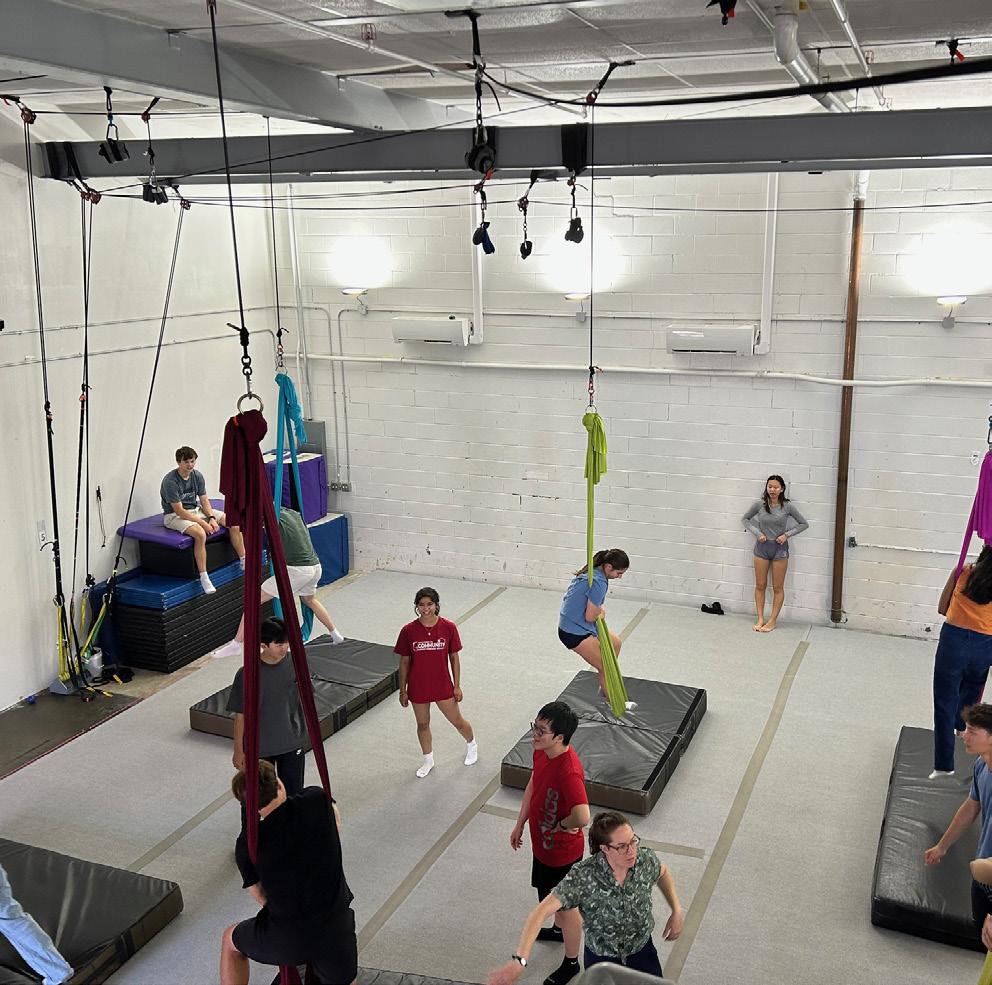
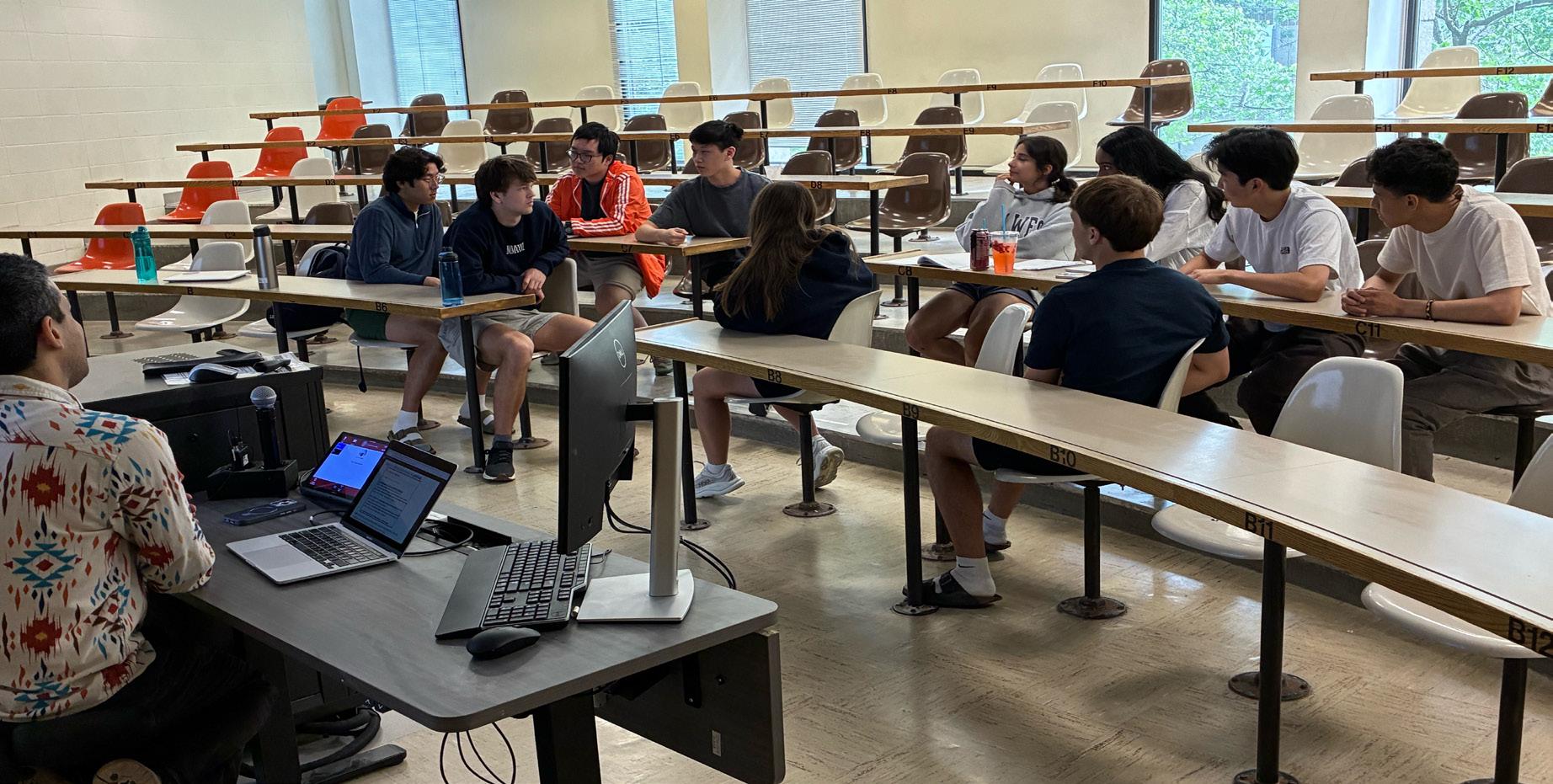
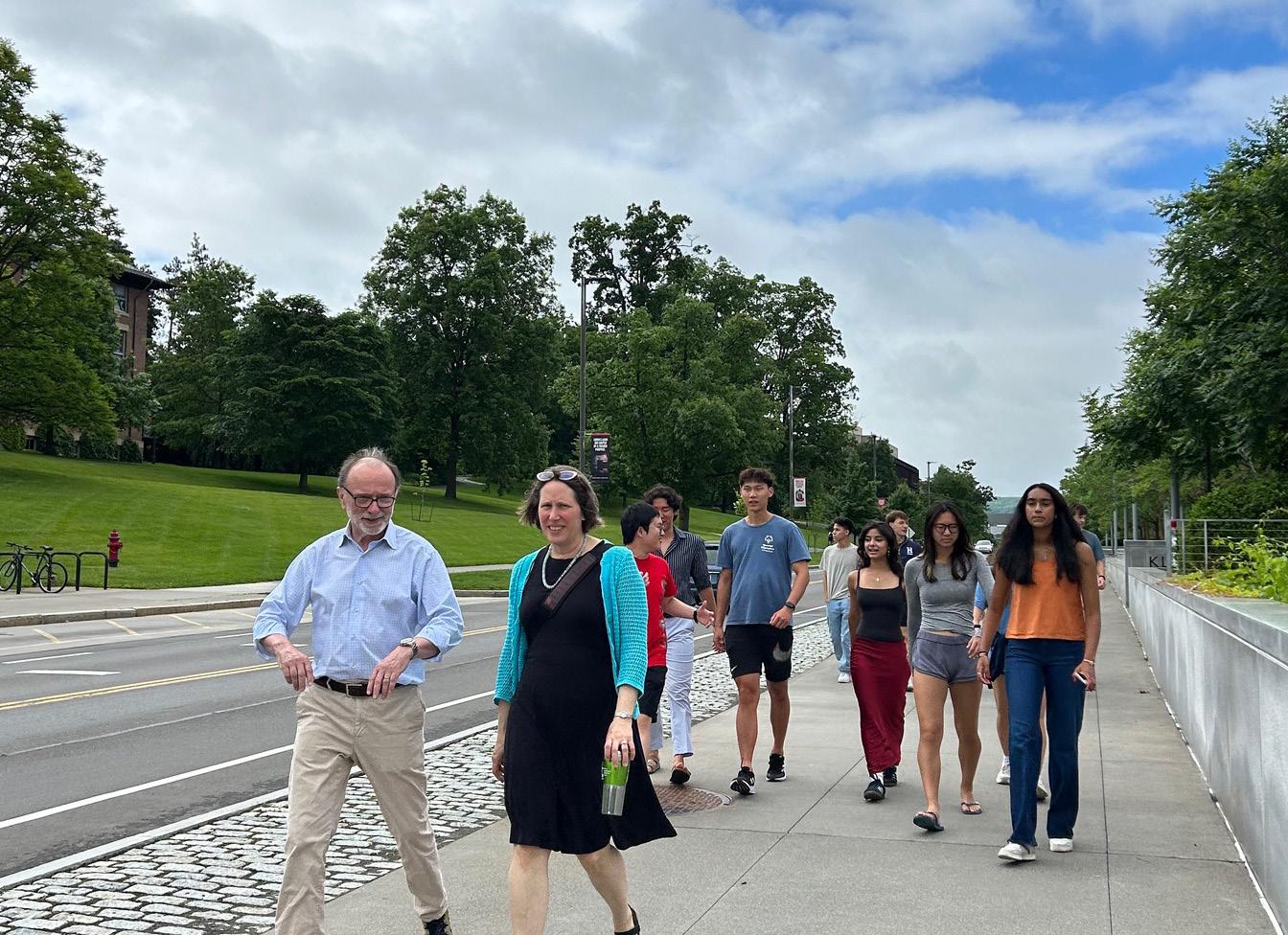

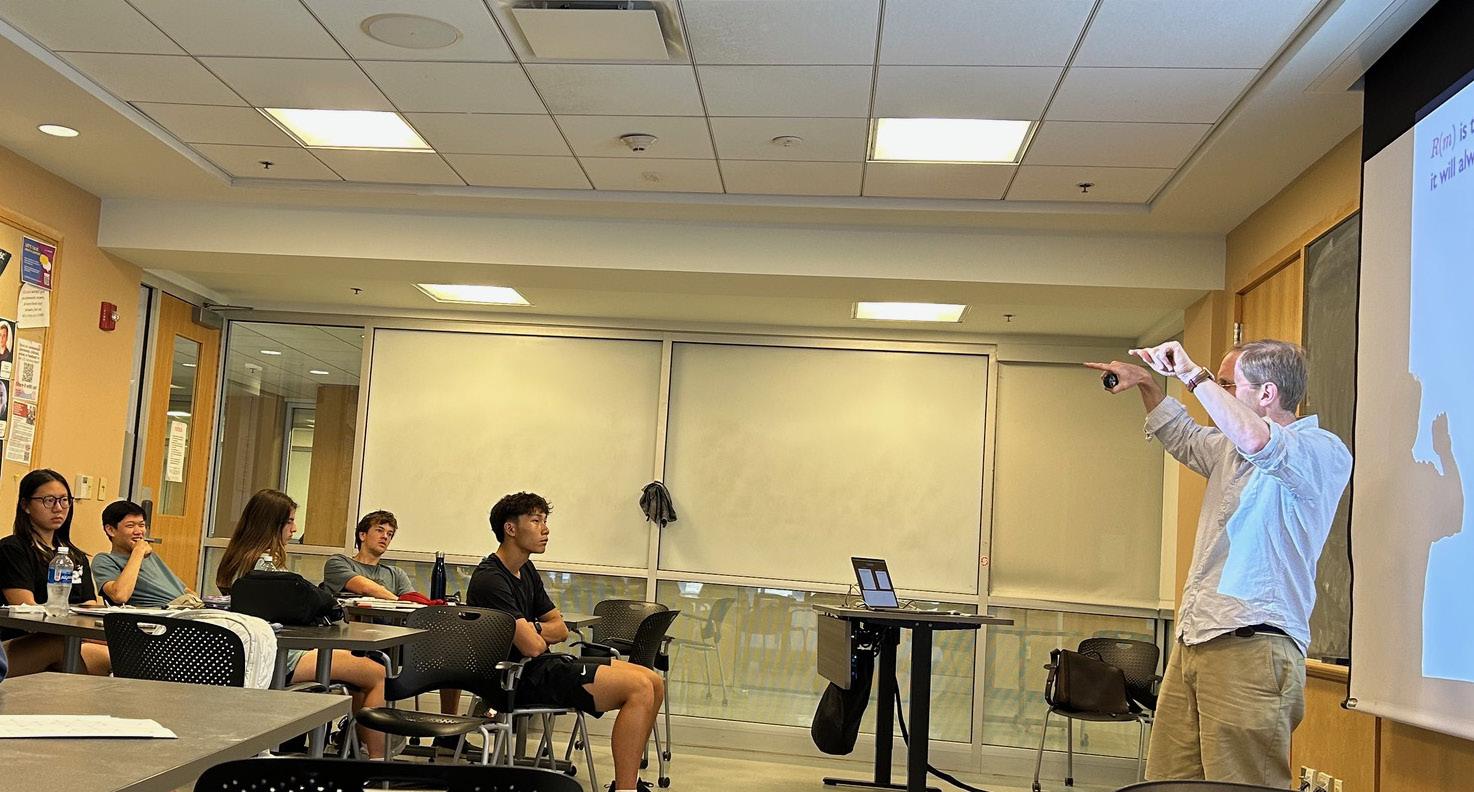
Our time at the program was made special through the opportunity to meet and talk with some of the Cornell Mathematics Department’s most inspiring figures, including Dr. Spoon (Librarian of the Mathematics Library), Professor Tara Holms (Head of Cornell’s Mathematics Department), Professor Moon Duchin, Professor Lionel Levine, and Professor Timothy Riley. Professor Holms kindly greeted us on the first day of our archival research, giving us a tour around the libraries we would be using, explaining the role of mathematical principles in 3D-printed fidgets, and narrating some of Cornell’s long-standing, unique traditions. Later, Professor Levine delivered a thought-provoking lecture on how math helps us think about AI safety. During the lecture, Professor Levine challenged students to engage in discussions debating the moral status of AI, what “control” over AI really means, and if it could lead to human extinction. The next day, professor
Duchin discussed her unique career path at the intersection of mathematics and public policy. She educated the scholars on her recent research that explained how to draw electoral districts to achieve a fair outcome in a democratic election. And finally, Professor Riley visited the scholars as a guest during one of their afternoon math lectures, where he discussed “Big Numbers” and his research into geometric group theory. Scholars played a game where they had to avoid making monochrome triangles, learned about Hydra, and thought about how to express the greatest whole number in only words and mathematical notion—a feat much harder than we had first thought!
In retrospect, we left Cornell not just with new knowledge, but with a deeper excitement for where math can take us, along with gratitude for the special guests who were willing to share their time and passions with us.

